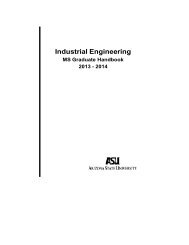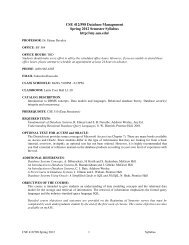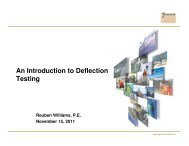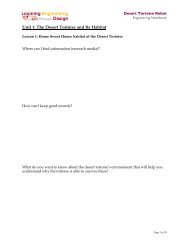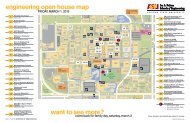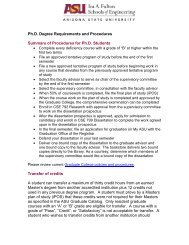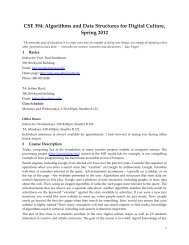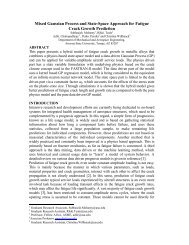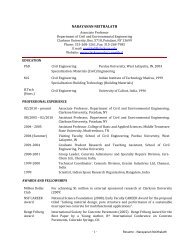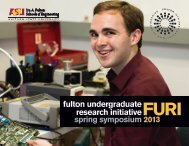2003-2004 Department of Computer Science and Engineering
2003-2004 Department of Computer Science and Engineering
2003-2004 Department of Computer Science and Engineering
You also want an ePaper? Increase the reach of your titles
YUMPU automatically turns print PDFs into web optimized ePapers that Google loves.
Reseach CentersPDA-sized computer receives a video input stream from a wearablecamera (which is mounted in a pair <strong>of</strong> glasses worn by the user) <strong>and</strong>communicates what it “sees” through tiny sound emitters in the earpieces<strong>of</strong> those same glasses. This wearable device can also communicate withthe “smart objects” that populate ubiquitous environments. Private <strong>and</strong>public environments will be increasingly populated with intelligent devicesthat are capable <strong>of</strong> communicating wirelessly with other devices.Information about rest rooms, vending machines, signs, kiosks, <strong>and</strong> evenrestaurant menus can be communicated wirelessly to this wearablecomputer.Based on inputs collected from focus groups <strong>of</strong> people who are blind,mobility instructors, <strong>and</strong> relatives <strong>of</strong> those who are blind, CUbiC identifiedseveral types <strong>of</strong> problems that the participants identified as being a toppriority. Based on these problems, Cubic researchers then began researchto support the development <strong>of</strong> the following assistive devices:■ The iCARE Reader allows users to read <strong>and</strong> study books, <strong>and</strong> otherhardcopy textual material. As part <strong>of</strong> this project, CUbiC researchersare running experiments in which two people (one blind <strong>and</strong> onesighted) collaboratively read books. By analyzing the video captured during these reading sessions, CUbiCresearchers can study the interactions needed to support collaborate reading, <strong>and</strong> then define an intuitive protocolfor human-computer collaborative reading.■■■■The iCARE Interaction Assistant facilitates person-to-person interaction between users who are blind <strong>and</strong> otherpeople that they encounter in their day-to-day life. It recognizes faces, facial expressions, non-verbal communication(such as eye contact <strong>and</strong> gestures), <strong>and</strong> human gait.The iCARE Information Assistant facilitates access to web sites that were designed to be navigated with mouseclicks. It downloads the content <strong>of</strong> the target web site, <strong>and</strong> parses that content based on semantic content. Theuser indicates what type <strong>of</strong> information he/she is most interested in, <strong>and</strong> the Information Assistant essentially“restructures” the web site content to bring the most relevant information close to the user. This relevant content canthen be accessed through a serial list <strong>of</strong> hyperlinks.The iCARE Haptic Interface allows persons who are blind to explore their distant environment with their h<strong>and</strong>s.Haptic gloves create virtual objects in the h<strong>and</strong>s <strong>of</strong> the user, to represent objects within the field <strong>of</strong> view <strong>of</strong> a headmountedcamera. The user aims the wearable camera in any direction, <strong>and</strong> “feels” the objects captured by thecamera.The iCARE Cognitive Interface allows persons who are blind to exchange information with a wearable computer atthe conceptual level, instead <strong>of</strong> at the data level which is the current paradigm. In order to this, CUbiC researchersare determining what visual concepts are evoked in the minds <strong>of</strong> sighted people, as they view their environment.One special application is face description, in which the face <strong>of</strong> a person, (as captured by a wearable camera) isdescribed in terms <strong>of</strong> salient facial features.Helping the blind to see is a worthwhile, but daunting, goal. To achieve it, CUbiC Director Sethuraman Panchanathanhas assembled an interdisciplinary team <strong>of</strong> researchers from <strong>Computer</strong> <strong>Science</strong>, Disability Studies, Psychology, <strong>and</strong>University Evaluation, as well two computer science students who are blind, <strong>and</strong> one psychology student who is blind.Their work is already helping people who are visually impaired, <strong>and</strong> is destined to have a significant impact on the futuredirection <strong>of</strong> ubiquitous computing research.ARIZONA STATE UNIVERSITY 15



